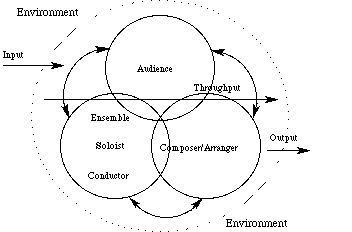
A system is a structure of interacting, intercommunicating components that, as a group, act or operate individually and jointly to achieve a common goal through the concerted activity of the individual parts. (Lewis Thomas, 1979).

Arrows show the action of cause/effect feedback loops. The dotted line indicates an "open" boundary that allows for interaction between a system and its environment.
Many aspects of music can be described and illustrated through use of systems models. A score, for example, is a system of interacting components which can include rhythm, harmony, melody, texture or color (instruments, voices, etc.). A score can be played for an audience by an ensemble. This situation, too, can be illustrated with a systems model as shown below.

In this systems model, the components (subsystems) intersect to illustrate that one element can reside within or take on the qualities of another.
For example, the composer can be a member of the audience or be a member of the ensemble that is performing his composition. An absent composer is not within the system. Rather, his/her score becomes "input."
The members of the ensemble may put themselves in the place of the audience in an attempt to simulate the effects of their performance on an audience. The ensemble (as audience) can hear a recording of its own performance. Active listening to other members of the ensemble is part of the ensemble process. The ensemble may be an improvisational group which originates its own music (thus supplanting the composer in the system). The ensemble subsystem can be detached from the system and operate as a system on its own, with input, throughput, and output. Individuals in the ensemble become subsystems, all interconnected by feedback loops.
The generic model can be adapted to help visualize the following as systems or constituent subsystems within the musical environment of concert halls, reheasal rooms, recording studios, mass media.
| Chamber Ensemble Large ensemble with conductor Composer, arranger, improvisor Audience, listener, critic Sound Recording, Video | Jazz Group Conductor, coach Score Culture, subculture, similar background/experience Telebroadcast, radio broadcast |
The generic model can be adapted to help visualize how the elements of composition or improvisation interact dynamically to create the whole system or organizm. Each of these elements can be visualized as a "cause and effect' loop.
Each element of composition can also be visualized as a system-within-a-system. Such visualization can promote the idea that the form of a composition or an improvisation is an accumulating effect which results from the dynamic interaction of the elements of a system.